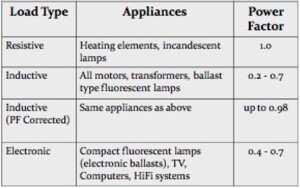Off-grid solar systems tend to require significantly more caution, care, and maintenance than grid-connected systems, where you can plug in and use any appliance you want without having to think about the consequences. The reason for this is that AC (alternating current, as opposed to DC, direct current) is the electricity flow type of choice in the grid-connected world, and the vast majority of household appliances have been designed with AC circuits in mind.
DC vs AC electricity
With DC electricity, the electrons (the power) flow in one constant direction, while with AC electricity, the electrons ‘alternate’ back and forth at mind-bogglingly high speeds. Two of the key advantages of AC electricity are that 1) power losses are less than with DC when AC power is transmitted over long distances, and 2) AC voltage can be relatively easily ramped up or down using devices called transformers; DC, by contrast, loses more voltage (and therefore power) over long distances, and its voltage cannot be easily altered to suit whatever appliance you may happen to be using.
Power and voltage are related but different. We can see this relationship in a simple equation: Power = Voltage * Current, or W = V * I. Power is usually measured in Watts (W), Voltage in Volts (V), and Current (symbolised by “I” but measured in Amperes – “A”). It is convenient to think of voltage as the ˜pressure’ of the electricity and current as its ‘flow’ – a bit like water being forced through a pipe. The water metaphor holds up pretty well in the case of DC, where it’s easy to imagine the water flowing in one direction, but becomes a bit more difficult to visualise with AC (can you imagine the flow of the water switching directions 50+ times/second?) The measurement of this alternation, called ˜frequency’, is measured in Hertz (Hz) and is not applicable to DC electricity. In Australia, for example, wall socket frequency is set at 50Hz AC.
Why DC vs AC matters in an off-grid solar system
So how is any of this relevant to you and your on or off-grid system? There are lots of reasons. The flow of energy produced by a solar/PV array is unidirectional – DC. The same is true for all batteries. The problem is that many appliances, including anything that contains a motor (your washing machine, electric razor, etc), will only function on an AC circuit, and most other appliances are designed for AC anyway because it is the standard for home electricity. (If you want appliances specifically for DC circuits, you have to ask for them.) For this reason, your solar/PV system needs an inverter, which will convert the DC from your batteries and PV array into usable AC electricity – so you can run your washing machine and so on.
Unfortunately, converting DC to AC can come at the cost of energy efficiency. The conversion efficiency ratio is known as the ‘power factor’ (PF), and differs from appliance to appliance. AC appliances are rated with a power factor between 0 and 1. This is essentially the efficiency of the conversion from DC to AC electricity, where 1 is 100% or ‘unity’ with the DC power equivalent. Where does the efficiency loss come from? It’s a bit technical, but it has to do with whether the current and voltage are ‘in phase’, meaning that they are alternating at the same rate. (DC electricity has no phase, so this problem doesn’t arise with DC.) DC power is usually expressed in kVA (kilo Volt Amperes), known as ‘apparent power’. Since there is no phase to factor in, with DC, kVA = kW. In AC, however, the ‘real’, ˜true’ or ‘actual power’ – the amount of power the device can be observed to be using – is actually less than the ‘apparent power’. The balance is lost in excess current – it’s there, but doesn’t do any useful work, and hence is not ‘real’. AC power can be expressed in the equation kW = kVA * PF.
Power factor in various AC appliances
Different types of devices have different power factor ratings. The following chart provides a very rough guide to typical PF values, but for exact numbers you’ll need to inspect the device you intend to use or consult its maker. As you can see, some devices are ‘power factor corrected’ (PFC) in order to reduces the losses inherent in AC/DC conversion. You can also see that resistive devices suffer no drop in efficiency from the conversion.

In an off-grid system, it is possible to run some of your AC devices, such as incandescent light bulbs or soldering irons directly from your batteries without passing through the inverter. Additionally, it is possible to get appliances such as refrigerators designed specifically for DC electricity flows. A direct DC setup could save you energy and money in the long-run, but you’ll have to get your installer/electrician to set up a separate circuit up for you. Ultimately, it will be up to you to determine whether the energy savings achieved by using a DC circuit will be worth the cost of having it installed and buying the DC appliances.
Get a free comparison of solar & battery quotes from installers who operate in your area!
© 2017 Solar Choice Pty Ltd